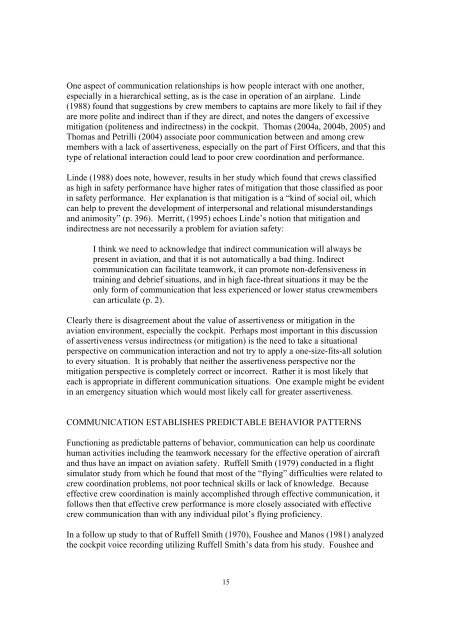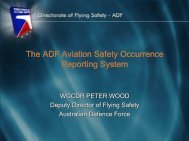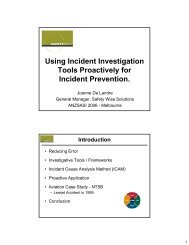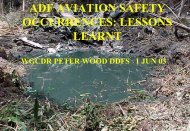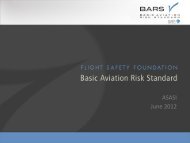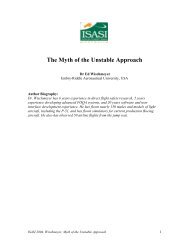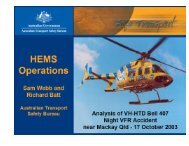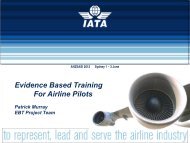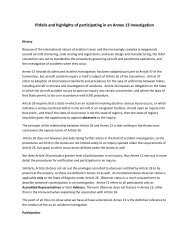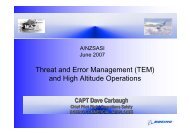communication in aviation safety: lessons learned and ... - ASASI
communication in aviation safety: lessons learned and ... - ASASI
communication in aviation safety: lessons learned and ... - ASASI
Create successful ePaper yourself
Turn your PDF publications into a flip-book with our unique Google optimized e-Paper software.
One aspect of <strong>communication</strong> relationships is how people <strong>in</strong>teract with one another,especially <strong>in</strong> a hierarchical sett<strong>in</strong>g, as is the case <strong>in</strong> operation of an airplane. L<strong>in</strong>de(1988) found that suggestions by crew members to capta<strong>in</strong>s are more likely to fail if theyare more polite <strong>and</strong> <strong>in</strong>direct than if they are direct, <strong>and</strong> notes the dangers of excessivemitigation (politeness <strong>and</strong> <strong>in</strong>directness) <strong>in</strong> the cockpit. Thomas (2004a, 2004b, 2005) <strong>and</strong>Thomas <strong>and</strong> Petrilli (2004) associate poor <strong>communication</strong> between <strong>and</strong> among crewmembers with a lack of assertiveness, especially on the part of First Officers, <strong>and</strong> that thistype of relational <strong>in</strong>teraction could lead to poor crew coord<strong>in</strong>ation <strong>and</strong> performance.L<strong>in</strong>de (1988) does note, however, results <strong>in</strong> her study which found that crews classifiedas high <strong>in</strong> <strong>safety</strong> performance have higher rates of mitigation that those classified as poor<strong>in</strong> <strong>safety</strong> performance. Her explanation is that mitigation is a “k<strong>in</strong>d of social oil, whichcan help to prevent the development of <strong>in</strong>terpersonal <strong>and</strong> relational misunderst<strong>and</strong><strong>in</strong>gs<strong>and</strong> animosity” (p. 396). Merritt, (1995) echoes L<strong>in</strong>de’s notion that mitigation <strong>and</strong><strong>in</strong>directness are not necessarily a problem for <strong>aviation</strong> <strong>safety</strong>:I th<strong>in</strong>k we need to acknowledge that <strong>in</strong>direct <strong>communication</strong> will always bepresent <strong>in</strong> <strong>aviation</strong>, <strong>and</strong> that it is not automatically a bad th<strong>in</strong>g. Indirect<strong>communication</strong> can facilitate teamwork, it can promote non-defensiveness <strong>in</strong>tra<strong>in</strong><strong>in</strong>g <strong>and</strong> debrief situations, <strong>and</strong> <strong>in</strong> high face-threat situations it may be theonly form of <strong>communication</strong> that less experienced or lower status crewmemberscan articulate (p. 2).Clearly there is disagreement about the value of assertiveness or mitigation <strong>in</strong> the<strong>aviation</strong> environment, especially the cockpit. Perhaps most important <strong>in</strong> this discussionof assertiveness versus <strong>in</strong>directness (or mitigation) is the need to take a situationalperspective on <strong>communication</strong> <strong>in</strong>teraction <strong>and</strong> not try to apply a one-size-fits-all solutionto every situation. It is probably that neither the assertiveness perspective nor themitigation perspective is completely correct or <strong>in</strong>correct. Rather it is most likely thateach is appropriate <strong>in</strong> different <strong>communication</strong> situations. One example might be evident<strong>in</strong> an emergency situation which would most likely call for greater assertiveness.COMMUNICATION ESTABLISHES PREDICTABLE BEHAVIOR PATTERNSFunction<strong>in</strong>g as predictable patterns of behavior, <strong>communication</strong> can help us coord<strong>in</strong>atehuman activities <strong>in</strong>clud<strong>in</strong>g the teamwork necessary for the effective operation of aircraft<strong>and</strong> thus have an impact on <strong>aviation</strong> <strong>safety</strong>. Ruffell Smith (1979) conducted <strong>in</strong> a flightsimulator study from which he found that most of the “fly<strong>in</strong>g” difficulties were related tocrew coord<strong>in</strong>ation problems, not poor technical skills or lack of knowledge. Becauseeffective crew coord<strong>in</strong>ation is ma<strong>in</strong>ly accomplished through effective <strong>communication</strong>, itfollows then that effective crew performance is more closely associated with effectivecrew <strong>communication</strong> than with any <strong>in</strong>dividual pilot’s fly<strong>in</strong>g proficiency.In a follow up study to that of Ruffell Smith (1970), Foushee <strong>and</strong> Manos (1981) analyzedthe cockpit voice record<strong>in</strong>g utiliz<strong>in</strong>g Ruffell Smith’s data from his study. Foushee <strong>and</strong>15


